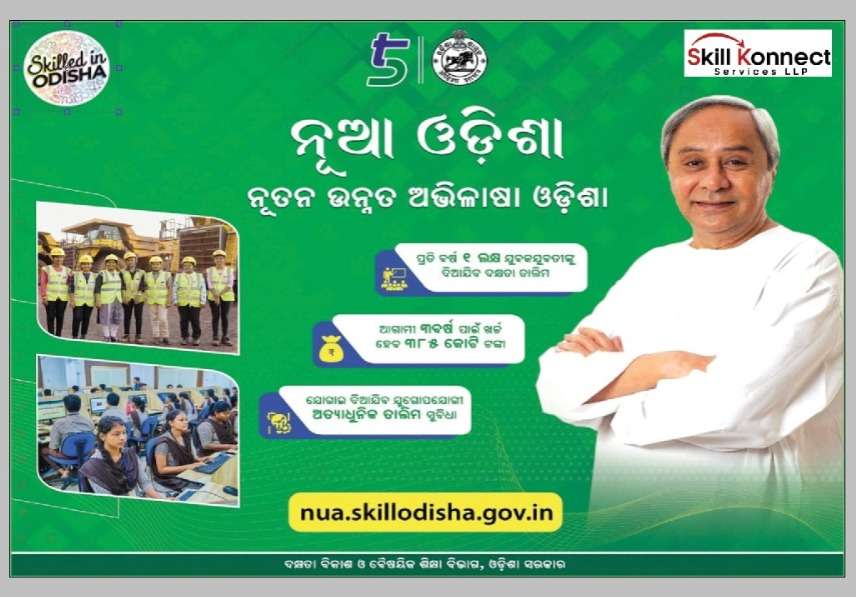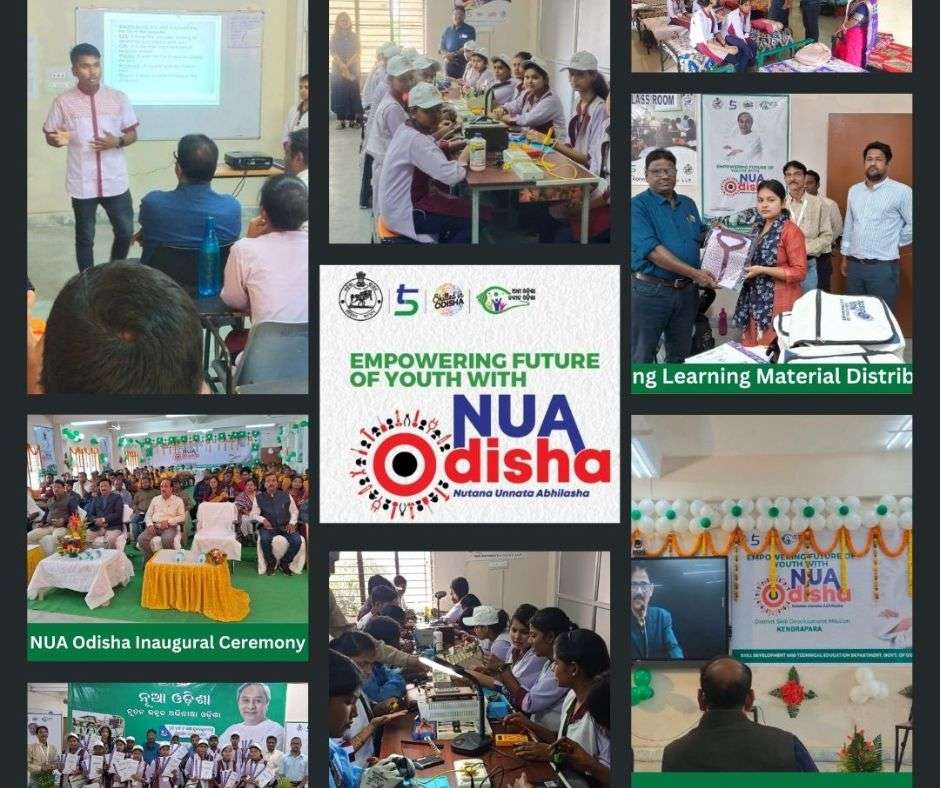Skilling Ecosystem in Odisha 2025: A Deep Dive
Odisha’s Skilling Drive: A Snapshot
Did you know that Odisha has trained over 36,000 youth in the last five years, placing more than 15,000 into jobs? With a labour force participation rate of 61.3% (above the national average), Odisha is becoming one of India’s strongest skill hubs. The state now aims to skill 1 million youth annually by 2047, building on its robust infrastructure of 467 training centres and 196 providers.

At the heart of this transformation is the World Skill Center (WSC), Bhubaneswar, a world-class finishing school preparing 2,000 students every year in advanced trades for both domestic and global markets.
Skilling Infrastructure: Institutions & Innovations
1. State-Led Institutions
- Odisha Skill Development Authority (OSDA): The apex body aligning training with industry demands and promoting the ‘Skilled-in-Odisha’ brand.
- World Skill Center (WSC), Bhubaneswar: An 18-storey, 500,000 sq. ft. facility with global curriculum, advanced labs, and a train-the-trainer model.
- Skill Development Institutes (SDIs): Focus on sector-specific training in oil & gas, healthcare, IT, and advanced manufacturing.
- NUA Odisha Scheme: A flagship initiative launched to expand skill training for youth across all districts with a focus on new-age trades like AI, robotics, digital marketing, and green technologies.
2. National & Global Collaboration
- National Centre of Excellence: One of five new world-class centres being set up in Odisha.
- Global Partnerships: Ties with Singapore’s ITE Education Services and international mobility programs prepare Odia youth for overseas opportunities.
- Foreign Placement MoUs: Odisha has signed agreements with countries like Japan for skilled manpower placement, especially in healthcare, manufacturing, and caregiving sectors. Such partnerships open global career pathways for youth trained under state and central schemes.
Who’s Being Skilled? Key Numbers
| Year | Trained (est.) | Placed in Jobs | Top Sectors |
| 2019-20 | 9,256 | 4,000 | Electrician, Plumbing, Healthcare |
| 2020-21 | 3,115 | 1,449 | Teaching, Vision Technician |
| 2021-22 | 5,415 | 1,733 | Sewing, Beauty Therapy |
| 2022-23 | 10,399 | 3,964 | Hospitality, Retail, Guest Services |
| 2023-24 | 8,108 | 3,922 | Welding, Refrigeration, Carpentry |
Total (2019–24): 36,329 trained | 15,068 placed
In 2025, 151,084 candidates are enrolled with 175,299 applications received. Importantly, 25% are women and 30% are from disadvantaged groups.
Placement & Industry Linkage
- Placement-Linked Training: Emphasis on real jobs, not just certificates.
- District-Level Customization: Skilling programs tailored to local industry needs.
- Global Placements: Certified training and soft skills prepare candidates for international markets. With new MoUs for Japan and other countries, Odisha is positioning itself as a global supplier of skilled manpower.
Driving Forces Behind Odisha’s Success
- Integrated Skilling Portal: Tracks enrollment, completion, and placement in real time.
Odisha has built a digital-first approach to skills. The Integrated Skilling Portal connects every training centre, provider, and candidate in one system. It tracks enrollment, training completion, and placements in real time. This means policymakers can see which district is performing, where dropouts happen, and which courses lead to jobs. In 2025 alone, the portal recorded over 175,000 applications and 151,000 enrollments across 489 centres. Employers can also log in to find certified candidates directly. This single dashboard has cut delays, reduced fake reporting, and brought transparency. Many trainees say it is the first time their progress is recognized instantly.
2. Grassroots Initiatives: Programs like Nano Unicorn (self-employment) and Sudakshya (for women) complement large-scale efforts.
Big institutions alone don’t solve unemployment. Odisha has backed grassroots programs like Nano Unicorn and Sudakshya to fill gaps. Nano Unicorn supports rural youth in starting micro-enterprises with small funding, mentoring, and local market links. Sudakshya focuses on women, providing free training, stipends, and job placements. These schemes have reached thousands across smaller towns and villages where large centres are absent. For instance, a group of women in Ganjam trained under Sudakshya and now run a tailoring unit that supplies uniforms to schools. Such stories show how Odisha is making skilling personal, inclusive, and accessible to the last mile.
3. Massive Investments: ₹32,000 crore in new industries (2024–25), expected to create 3.5 lakh new jobs.
Skill development works best when linked with real jobs. Odisha has seen fresh industrial investments worth ₹32,000 crore in 2024–25. These projects, spread across steel, chemicals, textiles, and electronics, are expected to create 3.5 lakh jobs in five years. Districts like Jharsuguda, Angul, and Khurda are major beneficiaries. To ensure these jobs go to locals, OSDA and training centres are aligning courses with company requirements. For example, new welding courses were launched in 2023 to support metal industries. This alignment of skilling with investments ensures that students don’t just get trained, but walk straight into jobs nearby.
4. NUA Odisha Initiative: Provides financial support, free training, and allowances for students pursuing skill development in new-age and emerging trades.

Launched in 2023, NUA Odisha is one of the state’s most ambitious youth programs. It gives free training, financial support, and even monthly allowances to students who enroll in skill development. The focus is on new-age trades—AI, robotics, digital marketing, green energy, and EV technologies. In 2024–25, over 1 lakh youth signed up under this scheme across all 30 districts. The state also provides soft skill and entrepreneurship modules to prepare them for self-employment. A success story is of a young graduate from Cuttack who used NUA Odisha training in digital marketing to start freelancing and now earns more than ₹40,000 a month.
5. District Skill Ecosystem: Mapping Gaps and Mobilizing Students
Odisha’s skilling drive doesn’t operate only at the state level. Much of its strength comes from the district skill ecosystem, where local teams play a critical role. Every district has a District Skill Committee (DSC) that acts as a bridge between government programs, training partners, industries, and communities. These committees review local labour market trends, identify priority sectors, and recommend courses that fit the district’s economy.
A screening committee within each district ensures that the right students are selected. They verify eligibility, check motivation levels, and align candidates with trades that suit their aptitude and job market demand. This process reduces dropouts and improves placement rates.
Student mobilisation is also a ground-level effort. District teams, often working with panchayats, SHGs, and NGOs, conduct awareness camps, career counselling sessions, and door-to-door campaigns. They not only inform youth about training opportunities but also encourage participation from women, tribal communities, and disadvantaged groups.
By combining screening, counselling, and mobilisation, the district ecosystem ensures skilling programs are not just available but also relevant, inclusive, and tied to real job opportunities. This localised approach is what helps Odisha close skill gaps district by district
In Focus: World Skill Center, Bhubaneswar
- Facility: 18-storey, 500,000 sq. ft. world-class campus.
- Capacity: 2,000 advanced students annually.
- Model: Dual training with global standards and advanced labs.
The World Skill Center (WSC) in Bhubaneswar is Odisha’s flagship project in advanced skilling. Housed in an 18-storey, 500,000 sq. ft. campus, it is designed to train 2,000 students every year in cutting-edge trades. The model follows a dual training system that blends classroom learning with hands-on practice in state-of-the-art labs.
In 2025, WSC invited applications for its September session, offering seven one-year advanced diploma programs under two schools: Engineering and Services. Engineering courses include Precision Engineering, Mechatronics, Electrical Technology, Mechanical & Electrical Services, Air Conditioning & Refrigeration, and Vertical Transportation. Under the Services school, students can pursue Beauty & Wellness.
World Skill Center Bhubaneswar | Skilling – Opportunities – Career | Special Discussion
WSC is powered by a global partnership with ITE Education Services, Singapore (ITEES), which ensures world-class curriculum, pedagogy, and assessments. Graduates often find opportunities both in India and abroad. In fact, Odisha has already signed MoUs for foreign placements, including Japan, in healthcare and manufacturing sectors.
Looking ahead, the state has also signed an MoU for a second WSC campus, which will introduce nine new programs such as Hospitality, Digital Animation, Aerospace Technology, Marine Engineering, and Nursing. With such initiatives, WSC is more than just a training centre — it’s a gateway for Odisha’s youth to step confidently into the future.
Odisha’s Rural Skills Drive: DDUGKY & ORMAS Impact
The Deen Dayal Upadhyaya Grameen Kaushalya Yojana (DDUGKY), implemented by ORMAS, has become a lifeline for rural youth.
Key Statistics (as of July 2025)
- Projects: 209 active.
- Enrolled: 221,229.
- Trained: 206,180.
- Certified: 128,598.
- Placed: 68,798.
ORMAS ensures quality with monthly monitoring, surprise visits, and post-placement tracking for 3–6 months.
Target 2024–25: Train 17,000 rural youth in one year.
Major Sectors: Hospitality, retail, healthcare, IT, and paramedical.
The Top 7 AI proof careers in 2025 you need to know.
SKILL DEVELOPMENT TRAINING CENTRE LIST/LOCATIONS.
Department-Wise Skilling Snapshot (2025)
| Department | Main Beneficiaries | Trained | Placed | Centres/Projects | Women/Minority Share |
| ORMAS/DDUGKY | Rural youth, SC/ST | 206,180 (since 2014) | 68,798 | 209 projects | 25% women, 30% SC/ST |
| OSDA | All youth (15–35) | 154,850 (recent year) | Data NA | 489 centres | 30% women, 20% minorities |
| OSFDC | SC/ST groups | 10,000–15,000 annually | Data NA | 30+ institutes | 60–80% reserved |
| OTDS | Tribal youth | 7,000–12,000 annually | Data NA | Cluster model | 50%+ tribal |
| NUA Odisha | Students, youth in emerging trades | Ongoing roll-out | Data NA | Statewide districts | Priority for women & minorities |
Final Takeaway
Odisha’s 2025 skilling ecosystem is more than numbers. It is a people-first, placement-driven movement where state institutions, global partnerships, MoUs for foreign jobs, and grassroots efforts work together. With NUA Odisha powering future-ready trades and international linkages like Japan placements, the state is preparing its youth not just for India but for the world.
NOTE | DISCLAIMER-
Its an honest & sincere effort to collect & corelate data, authenticity should be checked once from department/s. One can share any information on odisha skilling at
[email protected] , [email protected]
FAQs on Skilling ecosystem in Odisha 2025
Q1. How many skilling centres are active in Odisha in 2025?
Odisha has 467 centres and 196 providers, plus 209 projects under DDUGKY.
Q2. What is Odisha’s annual skilling ambition?
To skill 1 million youth every year by 2047.
Q3. What is the placement rate?
Around 42% of trained youth secured jobs in the last five years.
Q4. Which sectors dominate skilling?
Engineering, healthcare, hospitality, retail, beauty, advanced manufacturing, and digital skills.
Q5. How inclusive is the system?
At least 25% women and 30% disadvantaged groups are enrolled.
Q6. How is Odisha preparing youth for global jobs?
Through international partnerships, globally recognized certifications, soft skills training, and MoUs with Japan and other countries for placements.
Q7. What is the NUA Odisha scheme?
NUA Odisha provides free training, financial aid, and exposure in new-age skills like AI, robotics, digital marketing, and green technologies, ensuring youth stay relevant in emerging industries.







